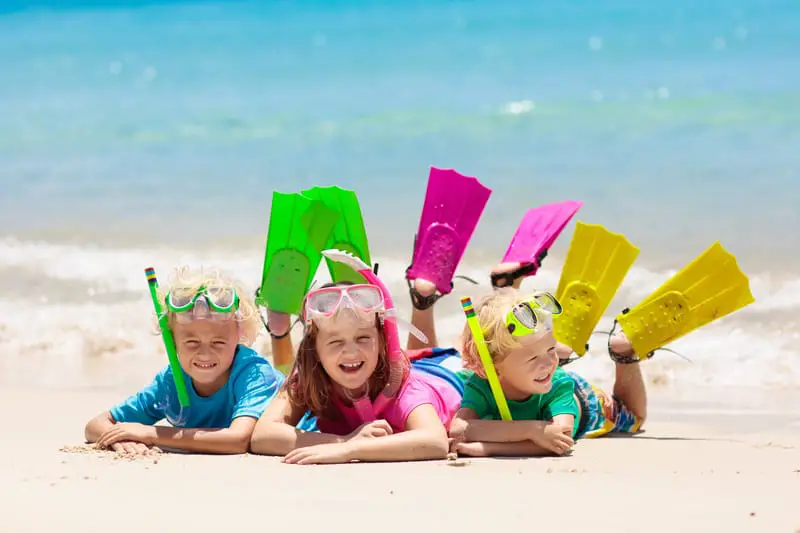
Taking your kids on a snorkel trip and letting them explore the marine life is a great family adventure. I remember when I was a kid and got my first snorkel mask in Spain, to me it was the adventure of a lifetime. However, being a father myself now, I bet my parents were on the watch 24/7.
I took my daughter snorkeling for the first time when she was 3 years old. We visited different snorkel sites over the past years and always looked after her safety. Nowadays, she’s 6, making big progress.
Over the years, there was a whole lot to learn. Based on our own research, and our own experience, me and my wife set up this snorkel guide for kids. Tips, tricks, gear, safety, we list it all for you below.
At What Age Can Kids Snorkel
Usually, between age 5 and 6, a child should be able to snorkel for the first time. However, every child is different, which means there’s no exact rule on when to give it a go.
This raises the question, how about kids that are younger and can’t wait to follow mom and dad into the ocean? From our own experience, we know that our daughter was capable to put on a snorkel mask at the age of 3. This included the snorkel. She had to wear swimming armbands (float sleeves) and we made sure to hold her hand all the time. Further down below we’ll give you some tips on how we made her feel comfortable in the water.
At age 4 our daughter started swimming lessons. This is when we switched from the float sleeves to a snorkel vest for kids. We let her snorkel only in calm and shallow waters. In the beginning we lifted her from her belly, but she didn’t like that at all. Therefore, close to the beach, we let her swim a little by herself whilst staying next to her at all times.
At age 5 we gave her a little more freedom. She had swimming lessons for about 1,5 years and she felt more confident. Snorkeling next to each other, giving the “underwater thumbs up”, going out just a little further when currents were weak, things of that nature. She still wore a snorkel vest. New gear were the fins.
Nowadays, at age 6, she’s feeling like a fish in the water. The snorkel vest is a must whenever we go out a little bit, but close to the shore she prefers not to wear one. She’s practicing to dive more often, like touching the bottom or picking up stones. Off course we always pay attention to what she’s doing, but we can say she’s definitely enjoying herself.
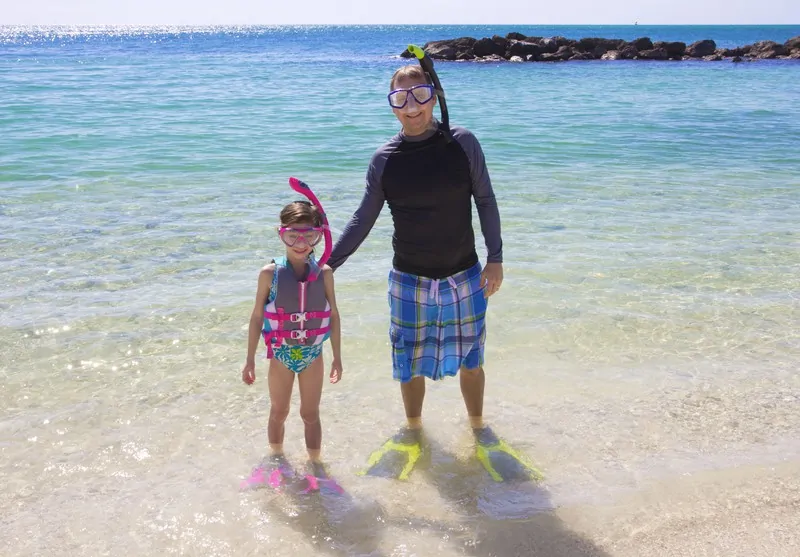
Tips For Snorkeling With Kids
Step 1: Getting Used To The Mask
I remember when my daughter was playing with my snorkel mask on her very first holiday. She was 2 years old. At one of the beach shops I bought her her own, not to use it in the water, but because on holiday kids like to get presents. She understood it was hers, and she could play with it whenever she wanted. Just make sure there are no parts that can be detached, and don’t have them put anything into their mouth.
Step 2: Start Practicing In The Bathtub
Back home we added it to her toys that she plays with in the bathtub. We showed her how to put it on, and whenever she let us we’d put it on her head as well. It didn’t take long until she was able to do that by herself. First attempts to look underwater followed quite naturally. When she was 3 we attached a snorkel to the mask. Joining her in the bath, showing her over and over again, without forcing anything, it all went like ABC. Still, she didn’t dare to breath through the snorkel for more than a few seconds.
Step 3: Let Them Practice In a Swimming Pool
The next step was to practice in a swimming pool. We did so on our next holiday in Spain. We put on her float sleeves and let her decide when to dip her head into the water. Make sure to leave that decision up to your kid. From our experience we can say that if there’s an interest for snorkeling, things will work out just fine. Especially since kids like to copy whatever mom and dad are up to. So if you do it first, there’s a good chance they’ll follow.
Step 4: Make Them Curious
Once your child is used to float in a pool, and once they dare to take a look underwater, it’s time to get used to breathe through the snorkel a little longer. Some kids will learn fast, whilst other could find it scary, especially since breathing through your mouth underwater is not a natural thing to do.
What we did is this: Whilst my wife and daughter were floating in the pool together, I grabbed her plastic toy fish and showed her how it was swimming as well. I put on my snorkel mask and started to do the same underwater, all the way to the bottom of the pool. And yes, it didn’t take too long before she got curious about her swimming toy fish. Where did it go? Where is daddy? Let’s check underwater! Getting used to breathe through a snorkel can take time, just make sure to let them practice at their own pace.
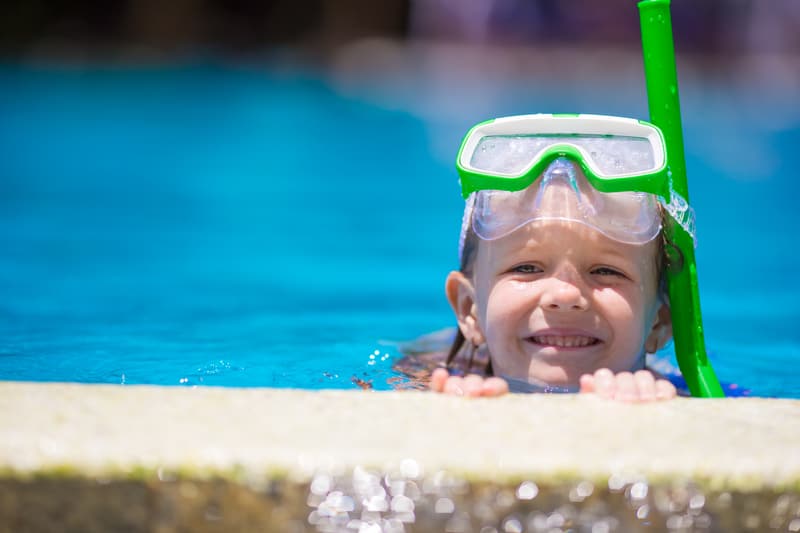
Step 5: Getting Used To The Ocean
Most kids have already experienced the ocean and it’s waves in a playful way, like holding on to one of their parents whilst they walk into the water. By using float sleeves, if they want to, they can experience the feeling of how the ocean moves by themselves as well. We practiced this in a previous holiday already, so at the age of 3 (3,5 years to be accurate), it was time to put on our snorkel gear.
Step 6: First Time Snorkeling In The Ocean
Now that your kid already has some snorkel practice, and there’s no anxiety for the ocean, let’s see what happens. Make sure to try this when the water is calm, preferably not too cold, and when visibility is good. For kids, a first experience is of big importance. So make sure it’s a good one. Hold their hand, make sure they’re safe and relaxed, and let them just play around. Hold them in an upright (vertical) position as if they’re standing. This gives confidence.
Step 7: Try Swimming
Moving from a vertical position to a horizontal swimming position can be a learning curve, however, most kids will find their way automatically. They’ll just copy whatever you’re doing. Make sure to hold them by the hand or support them below their belly. Swimming can be tiring so make sure to carry them for a short break regularly. In our case, our daughter couldn’t wait to “flipper” her feet and try to spot some fish.
Step 8: Changing To A Snorkel Vest
All the details about snorkel gear for kids are listed further down below. However, from our own experience, we have learned that switching from the floating sleeves to a snorkel vest was a good choice at the age of 4. We see many parents making this switch earlyer, and I guess there’s no real timing. Our daughter had no problems with the sleeves and we thought, as long as she doesn’t complain, let’s just let her enjoy. As soon as swimming lessons started, it was obvious that a vest was the next step to take.
Step 9: Teach Them The Basic Rules
One of the most important things any child should understand, is that he or she is not the only one trying to take a glimpse at the marine life. Kids can sometimes move their feet aggressively, which helps them to move in a certain direction. However, make them aware of other snorkelers. Bare feet, shoes or fins can hurt other people that happen to snorkel nearby.
Besides that, we told our daughter to quit whenever there’s water leaking into her mask, whenever there’s water entering through the snorkel, or whenever she’s feeling tired. Remember, snorkeling is a learning curve, even for adults.
Make sure to practice the basic hand signals for communication. Tell them which signal mean ” everything is ok”, which one means “danger, let’s go”, which one means “bring face above sea level”, which one means “follow”, things of that nature.
Instruct your children to not touch the sea life. This includes the corals. Don’t go anywhere near rocks, caves or other dangerous places. More safety instructions for snorkeling with kids can be found on this website.
Step 10: Expanding Gear
Kids grow, which means new snorkel gear is necessary regularly. Bigger masks, bigger fins, bigger vests, it’s something to pay close attention to. Learn more in the next paragraph.
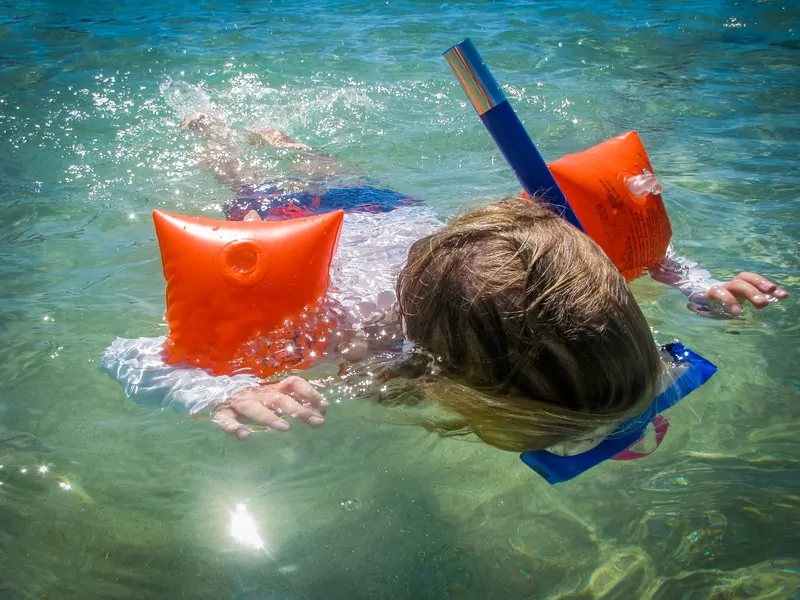
Snorkel Gear For Kids
Choosing The Right Mask
Choosing the right mask is so important. It can literally make the difference between a good and a bad experience. There are 2 types of snorkel masks: The regular mask and the full face mask.
Our daughter has only used the regular mask, and we have our reasons for that. First of all, she got used to wearing that in the bath tub, so why change a winning team. Secondly, it’s a good practice to hold your breath. When you start just with the mask, so without a snorkel, kids get used to holding their breath underwater. In most cases, depending on the mask, breathing through a full face snorkel mask is no problem for an adult. Some kids however experience difficulty.
We’re not saying the full face mask is a bad buy. We own a few ourselves and use it quite often. And we’re very pleased with it. However, some people say there’s a risk of CO2 build-up. So we say, just to be safe, don’t give one to a child. For us, the main reason to wear it, is because of the built in GoPro mount. The one we use has a “new” airflow technology, allowing maximum air intake, and we really can’t complain about getting dizzy or anything like that. For a child however, just don’t take any risks.
If you’re curious about the full face snorkel mask we use, together with lots of related information, feel free to read our full face snorkel mask review.
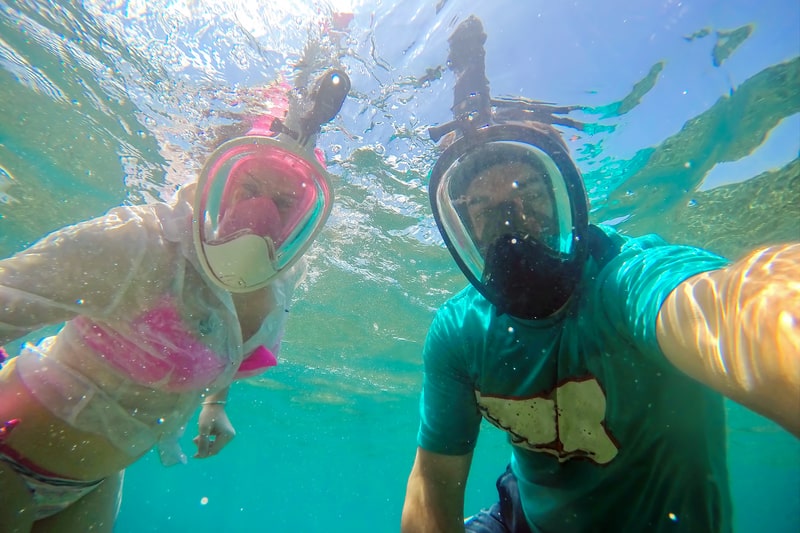
So, which mask should you choose?
For a good fit, go for a mask with a soft, hypoallergenic silicone seal. This will prevent water from coming in and adds to the comfort of wearing it. The lenses should be made from tempered glass that are scratch resistant. Also, make sure the mask provides a wide vision. The strap should allow for continuous adjustments and it’s even better if the seal fits any facial profile.
Our tip would be to buy a set with both a mask and a dry snorkel. We tried different sets on our daughter, usually within the 25 dollar range. The one set that lasted from when she was 3 years old, until she turned 6, was this one (picture below). You can’t go wrong, it’s good quality and you can even choose between four colors. Buying expensive gear is not necessarily better, at least, that’s my opinion.
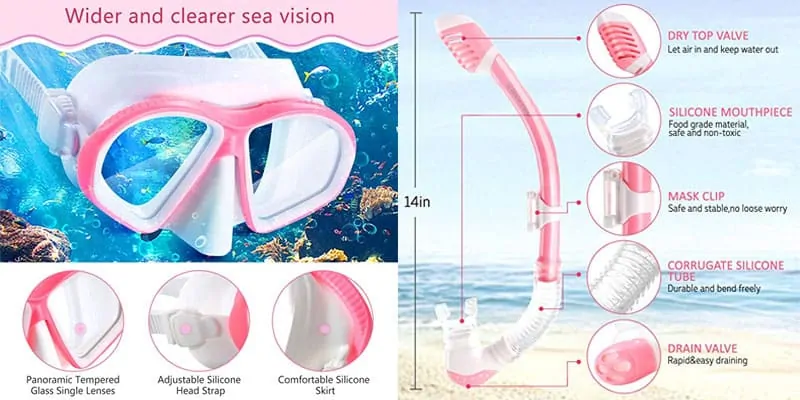
This is the snorkel set that stood the test of time for our daughter. She used it from ages 3-6. If you click the link above you’ll find it at Amazon.com, together with it’s latest price. We bought another set now that she turned 6, she has only used it once, and besides, it’s also fun for a kid to try new gear every once in a while. If you’re curious, this is the one we got. No problems whatsoever.
For an in depth snorkel set review (for both kids and adults), you can find my full review here.
Consider a snorkel with a purge valve. They make it easy for your kid to get rid of any water that managed to enter their snorkel (like the above picture demonstrates).
Choosing The Right Snorkel
In case you don’t want to buy a snorkel set, or in case your kid already owns a mask, a snorkel will be a great addition. Make sure to get a (semi) dry snorkel. A dry snorkel avoids water to enter whenever it submerges. At least, for the most part. There are a lot of snorkels to choose from, this is the one we once bought. It’s meant for kids somewhere between 5 and 10 years of age. If it’s time for a new mask as well, we suggest you go for one of the snorkel sets, like the one we mentioned above.
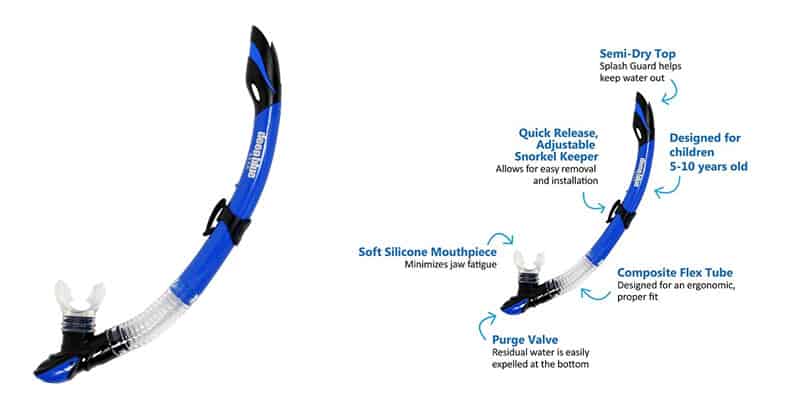
Do Kids Need Fins To Snorkel?
In my opinion it’s an awesome addition once your child is able to swim. We bought some for our daughter when she was 5 years old. She had swimming lessons for over a year and we thought it was time to get some fins. We notices she didn’t need to stand that often, in order to get some rest, which in my opinion is an important sign before switching to fins. For a kid, fins are definitely not mandatory, but once they can swim, it absolutely adds to their excitement. And that’s lovely to see.
There are 2 types of fins: Closed pocket fins and open heel fins. Also, there are long and short fins. So which ones should you choose?
The big advantage of open heel fins is that they’re adjustable in size. The downside is the fact that they should be worn with aqua socks or water shoes. Closed pocket fins are usually worn with bare feet, and they feel lighter to the legs. However, once your kid’s feet grow, they won’t fit anymore.
We decided to go for the open heel fins. Even though we had to buy new water shoes at some point, the fins still allowed for a good fit. We prefer our daughter to walk in water shoes, especially when the area is rocky. She was used to do that anyways, so it was an easy decision to go for the open heel fins.
Also, the fins are pretty short. The big advantage of short fins is their flexibility. They’re easy to handle and require less energy. Maybe, at some point, we’ll go for longer fins. We leave it up to her. No complaints thus far.
If you wonder which fins we bought, don’t worry, you can check them out here. Off course, she wanted the pink ones. But they’re available in different colors. They cost around 25 bucks.
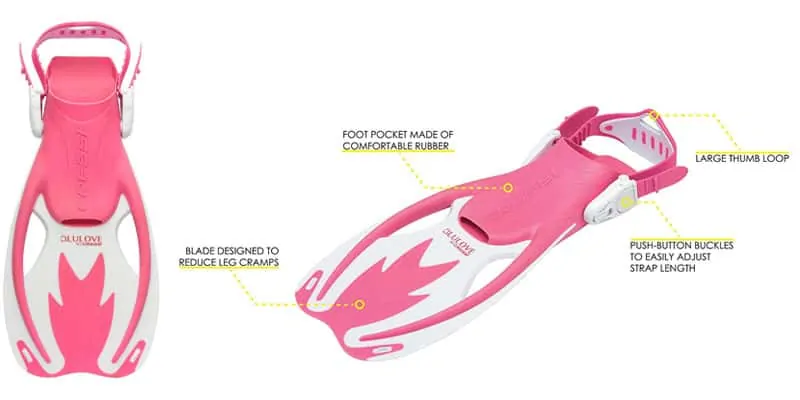
Water shoes usually cost around 10 bucks. These are the ones we got for our daughter a while back. Her new ones are from a local shop, so we can’t exactly show you which ones they are. But they’re pretty much the same quality.
If you’d like to learn more, even if it’s for yourself as a parent, feel free to visit our snorkel fins review.
Float Sleeves And Snorkel Vests
Starting with float sleeves, in my opinion, is a good and safe choice. Often kids are used to them anyways, so why not stick with them. It keeps your child in a vertical position, but also allows them to do some horizontal swimming. Our daughter didn’t mind them that much until she turned 4, I guess for kids it’s all about the sea life.
Alternatively, some parents prefer a puddle jumper. We never tried one, but it seems many kids enjoy wearing them. They have a little more lift than the float sleeves, and especially when kids are very young, it could be a good option.
At the age of 4 we switched to a snorkel vest. Now, with snorkel vests, it’s important to buy one that’s made for kids. We tried a few different ones over the years, and to be honest, it’s best to buy one from a local shop where you can try it on. The better the fit, the more comfort your child will experience. In case you need to order one online because there’s no shop nearby, you could consider this one. Neon colors are always good to be noticed by others.
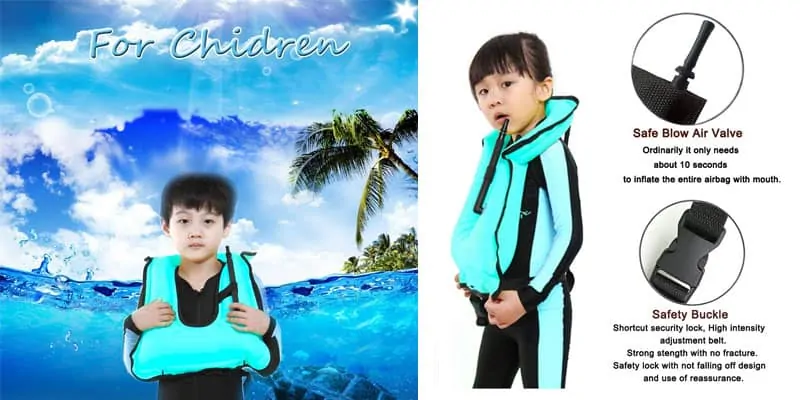
Swim Trainer Vests are another great option. We would recommend one in case a child simply won’t wear their floating sleeves. Some can’t stand them, and some don’t think they look “cool”, if you know what I mean.
Swim Trainer vests are pretty similar to the snorkel vest we just mentioned. They are available for kids aged 2-4 years, and for kids aged 4-6 years.
The big advantage they have, is that they help first-time swimmers to gain confidence in the water. Also, if you buy a decent product, it’ll provide a UV50+ sun block for the covered area (chest and back).
In my opinion, the float sleeves are more of a “passive” way to float in the water, whilst the trainer vests are meant to actually practice a little swimming. From age 4-6, when swimming lessons usually take place, it could be a fantastic option though.
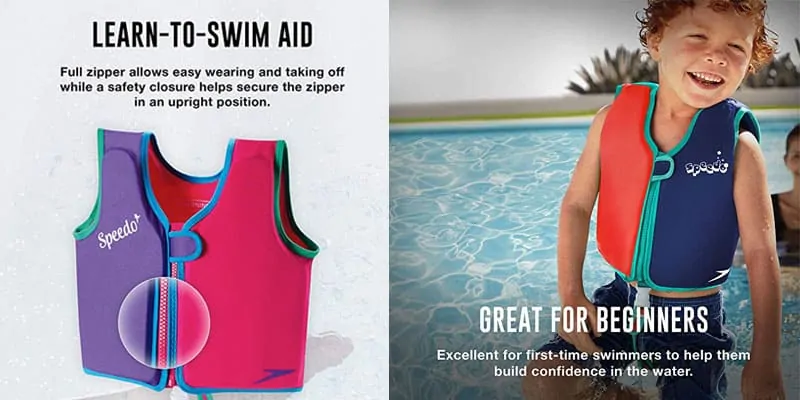
Wetsuits
In case you go snorkeling in cold water, a wetsuit may be a great option for your child. You have 2 choices: A short and a full-length wetsuit. I have a separate review about wetsuits for snorkeling where I discuss the pro’s and con’s.
We never bought one for our daughter, she doesn’t mind cooling down in the ocean, and we never really visited an ocean that’s freezing. But, if you visit a cold area, yes it can help you out big time.
In case you’re about to buy one for snorkeling, it’s best to go for a full-length wetsuit. Yes, they are more difficult to put on, but it’s definitely advised for snorkeling. A 2.5mm thick neoprene wetsuit is excellent for snorkeling. Get one that is stretchy in order to use it multiple times. They cost around 35 bucks for decent quality. Besides keeping your child warm, they also prevent reef injuries and provide UV sun protection (UPF 50+). If you want to get one, this could be a great option as it prevents jellyfish stings as well.
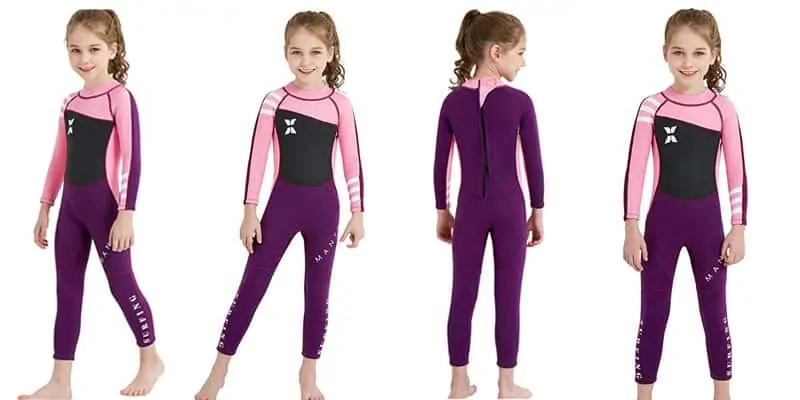
Sunscreen
It may sound obvious, but please make sure your kid is properly protected from sunburns. The wetsuit we just mentioned does the trick already, you just need to apply sunscreen to the face, hands and feet. However, if we take a look at ourselves, our daughter doesn’t wear one that often. So we make sure she gets a good layer of protection whenever we celebrate our holiday. Not only when snorkeling, but also at the pool, on the balcony, on the street, anywhere really.
Kids have a sensitive skin, and sunburns will definitely not make them happy. So, let’s make sure they enjoy throughout the whole experience.
When choosing a sunscreen, make sure it is water resistant, at least for a good amount of time. We use the SPF 60 for kids on our daughter, which is water resistant for about 80 minutes. Even for sensitive skin types this is the recommended cream. Dermatologists and pediatricians advise it as well. It’s not cheap, you pay almost 20 bucks for 200 ml of cream, but we never had any issues. More tips and gadgets on how to avoid sunburns are listed in our article about UV protection for snorkelers, swimmers and beach fans.
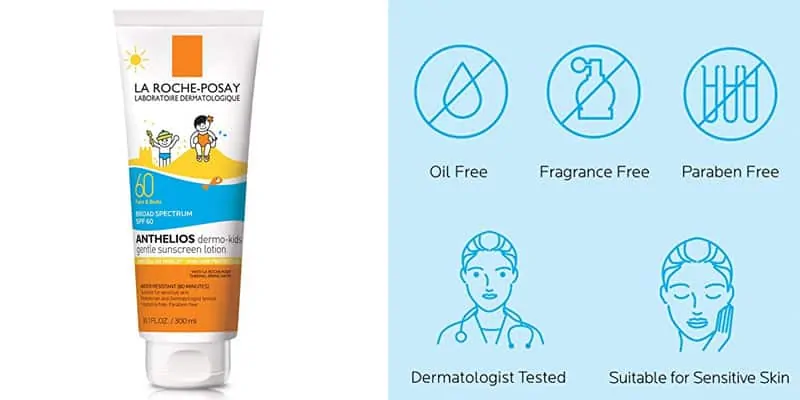
First Aid Kits
Since children can often become extremely excited whilst swimming in the pool or at the beach, a first aid kit could be something to consider. Often, hotels or lifeguards are able to help you out as well, but to be on the safe side, I always bring one.
If there’s enough space in your bag, it’s always best to carry a complete first aid kit with all of the necessary equipment. If storage is limited, you can also opt for a mini kit. This set includes both of them, so you’re always well prepared.
Take a few minutes to understand some of the basic things about stings, bites and scrapes. If necessary, write it down on a piece of paper and take it with you. More first aid details can be found on this website.
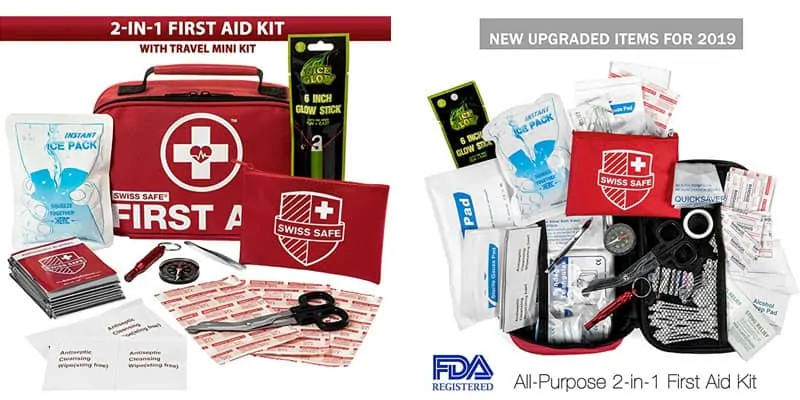
Waterproof Camera For Kids
Yes, this is a luxury gadget that you definitely don’t need in order to have a fun snorkel experience. However, if you’re considering to get one, here’s a great option.
This digital camera comes with a silicone handle which makes it a fun toy for anyone aged 4-15 years. It’s a great way to keep your child entertained. Besides, it’s fun to watch their pictures after a long day at the beach. Who knows what they were able to capture!
If you want, you could get an additional float strap to make sure the camera won’t sink by accident. Float straps can also come in handy for keys, sunglasses, or whatever it is you’re taking with you.
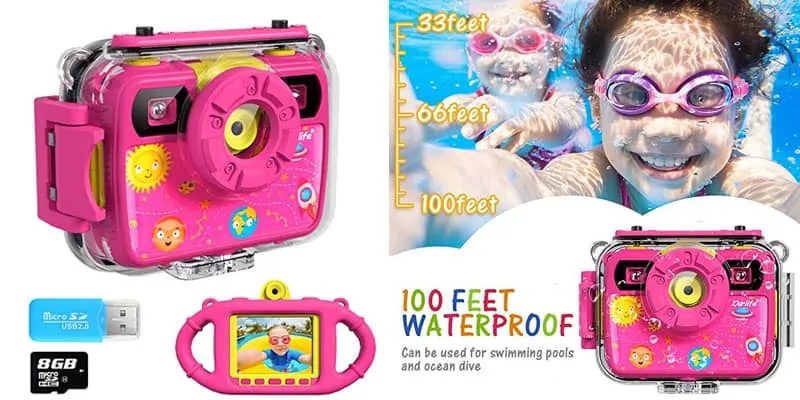
Tip: You’re probably aware that kids prefer to bring all kinds of gear to the beach. If you get them any new gadgets, think about transportation. If you don’t own one of those cool beach carts for sand, who’s doing all the carrying?
What We’ve Learned
So, before ending this article, let’s discuss all the things we ourselves experienced with our daughter. Besides learning how to snorkel, and trying on different gear, there’s still a whole lot to talk about.
Stay Hydrated
Throughout any snorkel holiday, it’s always important to stay hydrated. Make sure you and your kids drink enough water. Not just in the morning, but during the entire day. One mistake people sometimes make, is to only drink water once they get thirsty.
Try to drink about half a liter in the morning, especially since our bodies dehydrate overnight. Then, before snorkeling, try to drink a quarter of a liter. A thirsty kid on a snorkel adventure is definitely not fun. Throughout the day, aim to drink another liter of water. You can spread it out. Everyone’s body is different, some need more water than others, so please check with your doctor what he or she suggests. We’re just giving estimates.
Sunny and warm climates, like in Hanauma Bay or Punta Cana for example, always carry the risk of dehydration. Take water with you from your hotel, or find a nearby shop to get it from. Beach bars and restaurants could do the trick as well, but are usually more expensive.
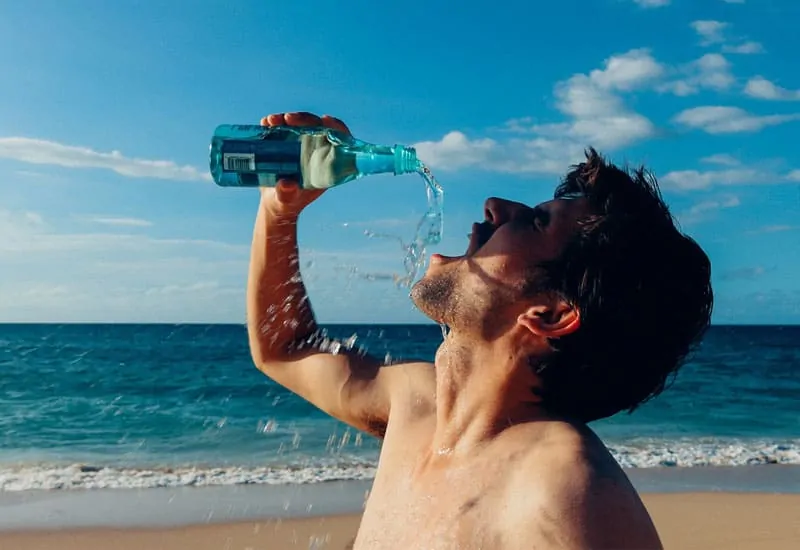
Watch Your Diet
Sure, for kids a holiday is certainly a time for treats and snacks. However, when you go snorkeling, try and eat some healthy food.
Breakfast is a great way to start the day, and it serves as an energy resource. Make sure your kids eat some fruits or eggs. Off course, we allow our daughter one of those delicious cakes as well, but only after she finished the healthy part. Too much sugar can actually make a child feel tired when exploring the marine life.
Another tip would be to have a good meal for dinner. Again, off course you need to enjoy it, and it’s not as if you can’t have any fast food once in a while. However, try and get your proteins wherever you can. You’ll feel more energetic in the morning.
Throughout the day, try and grab something to eat as well. But I guess, that’s something we all do anyways. Feeling hungry won’t make your kid any happier.
Tip: If you travel with young kids, we all know how an ice cream accident looks like. If you’re not planning to wash your towel every single day, check out our review about sand proof beach towels as well. They’re so much easier to clean, but of course, they come with other downsides.
It’s All About The Fish
Yes, definitely true, for our daughter snorkeling is all about seeing fish. Maybe for other kids this is different, but in our case, it’s all about the marine life. We’ve visited a few snorkel sites that include corals, but we never got the impression that she really notices them that much.
The fish shouldn’t be too big either. We once saw a pretty big turtle in Kauai, Hawaii, which freaked her out. The same thing happened when we saw a few triggerfish, which even scared me a little as soon as we got close.
So, in other words, try to pick a snorkel location that offers interesting fish within the small to medium size range. We’re not saying other kids can’t enjoy bigger fish, maybe it’s our personal experience that doesn’t reflect onto others, I’m just saying.
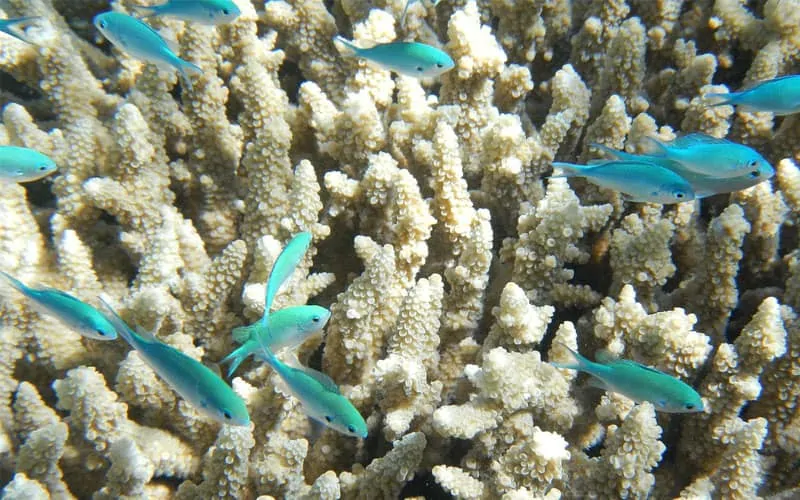
Preparation Is Fun!
Maybe my most favorite thing about snorkeling with my daughter, is how much fun she has when she knows we’re about to go to the beach. She packs her things as if she’s going on an expedition, she cleans her gear as if it’s the only snorkel set she’ll ever own, and she keeps reminding me to bring my camera as if I would forget it. Yes, snorkeling with kids is fun as soon as you wake up!
We taught our daughter how to clean her snorkel mask, and how to prevent it from fogging. At first we used a little bit of toothpaste to scrub the mask with a small toothbrush, and then rinse it. However, off course, she watches her parent spitting into the mask. So she does all that by herself now, sometimes before we’re even in the water. There are special anti-fog gels that prevent fogging as well, but in my opinion it’s best to make sure your kid knows how to deal with all of that at a young age. Snorkel gear is not cheap, so any unnecessary purchases can be skipped. At least, for me.
Tip: Consider to also read our helpful tips about cleaning snorkel gear.
Making Friends
Often, but not always, there are other kids either learning how to snorkel, or just having a family holiday all together. Seeing new friendships being established with your own child is a great experience. Combining snorkeling with some other activities, like building sand castles for example, gives me some time to rest.
To be honest, snorkeling with a kid can be quite exhausting. Me and my wife work pretty much full time, so whenever we go abroad, we like our share of relaxation. That’s why we always encourage our daughter to also spend some time on the beach. It allows us to simply take a seat, watch our daughter, and laugh about her huge imagination.
Together with other kids, there’s usually enough to do throughout the day. We never loose sight of her, but at least one of us is allowed to close his or her eyes for a short moment. Before you know it, it’s snorkel time again!
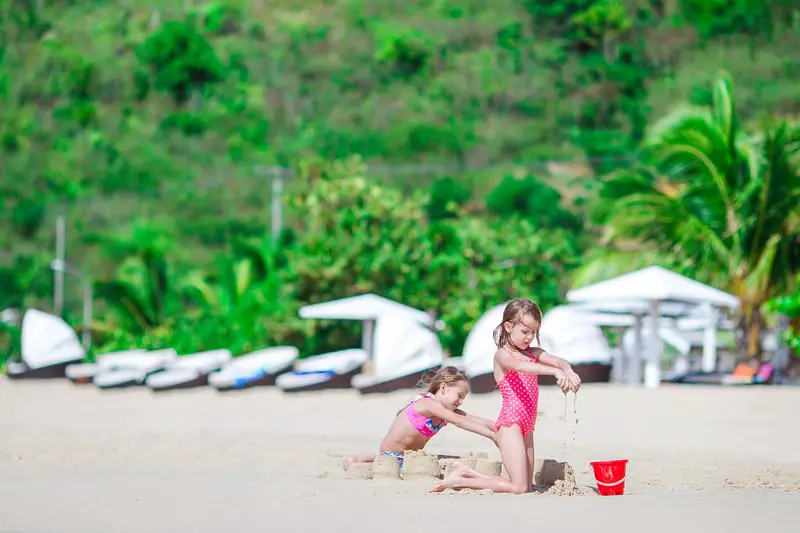
Education
A pretty cool and entertaining method to get kids excited for their snorkel adventure, is by telling them about the marine life. When they know up front which fish to see, and which ones are quite rare, it’s as if they can’t stop listening. Our Top 25 facts about fish should be interesting!
There are multiple websites that showcase which fish may be present at a certain snorkel location. Whether you travel by car or by airplane, it’s a good way to keep them entertained. It’ also fun to have your kid recognize one of the fish species, and even if our daughter is wrong, we stimulate her to keep on searching.
Sometimes, I show my daughter a few videos I’ve made with my GoPro. I usually stay close to the shore and the reefs, where the water is shallow. This gives her a good impression of what to expect. It also gives her confidence that following me around is safe and fun.
Another fun way to keep kids entertained are our aquatic emoji’s for their phones. Children these days are almost experts when it comes to digital connections.
Exercises
Do you need to do exercises before snorkeling? In my opinion it’s a good thing to do, but many people tend to skip it. If you’re already an athletic kind of person, you probably have a good condition and you may already be used to do some exercises. For kids it could be a good idea to do some simple stretching routines for a couple of minutes. We try to do a few before and after snorkeling.

